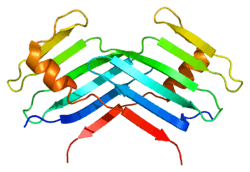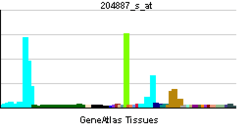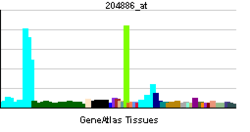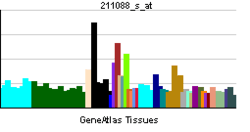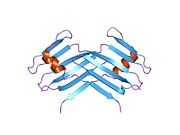PLK4
Serine/threonine-protein kinase PLK4 also known as polo-like kinase 4 is an enzyme that in humans is encoded by the PLK4 gene.[1]
Function
This gene encodes a member of the polo family of serine/threonine protein kinases. The protein localizes to centrioles, complex microtubule-based structures found in centrosomes, and regulates centriole duplication during the cell cycle.[1]
As a cancer drug target
Inhibitors of the enzymatic activity PLK4 have potential in the treatment of cancer.[2] The PLK4 inhibitor R1530 down regulates the expression of mitotic checkpoint kinase BubR1 that in turn leads to polyploidy rendering cancer cells unstable and more sensitive to cancer chemotherapy. Furthermore normal cells are resistant to the polyploidy inducing effects of R1530.[3]
Another PLK4 inhibitor, CFI-400945 has demonstrated efficacy in animal models of breast and ovarian cancer.[4]
Interactions
PLK4 has been shown to interact with Stratifin.[5]
References
- ↑ 1.0 1.1 "Entrez Gene: PLK4 polo-like kinase 4 (Drosophila)".
- ↑ Mason J, Wei S, Luo X, Nadeem V, Kiarash R, Huang P, Awrey D, Leung G, Beletskaya I, Feher M, Forrest B, Laufer R, Sampson P, Li S-W, Liu Y, Lang Y, Pauls H, Mak T, Pan JG. "Inhibition of Polo-like kinase 4 as an anti-cancer strategy". Abstract LB-215. Cancer Research. pp. LB–215.
- ↑ Tovar C, Higgins B, Deo D, Kolinsky K, Liu JJ, Heimbrook DC et al. (August 2010). "Small-molecule inducer of cancer cell polyploidy promotes apoptosis or senescence: Implications for therapy". Cell Cycle 9 (16): 3364–75. doi:10.4161/cc.9.16.12732. PMID 20814247.
- ↑ "Experimental drug shows promise in treating breast, ovarian cancer". News. Canadian Broadcasting Corporation. 2013-06-18.
- ↑ Rual JF, Venkatesan K, Hao T, Hirozane-Kishikawa T, Dricot A, Li N et al. (October 2005). "Towards a proteome-scale map of the human protein-protein interaction network". Nature 437 (7062): 1173–8. doi:10.1038/nature04209. PMID 16189514.
Further reading
- Kleylein-Sohn J, Westendorf J, Le Clech M, Habedanck R, Stierhof YD, Nigg EA (2007). "Plk4-induced centriole biogenesis in human cells". Dev. Cell 13 (2): 190–202. doi:10.1016/j.devcel.2007.07.002. PMID 17681131.
- Bettencourt-Dias M, Rodrigues-Martins A, Carpenter L, Riparbelli M, Lehmann L, Gatt MK et al. (2005). "SAK/PLK4 is required for centriole duplication and flagella development". Curr. Biol. 15 (24): 2199–207. doi:10.1016/j.cub.2005.11.042. PMID 16326102.
- Habedanck R, Stierhof YD, Wilkinson CJ, Nigg EA (2005). "The Polo kinase Plk4 functions in centriole duplication". Nat. Cell Biol. 7 (11): 1140–6. doi:10.1038/ncb1320. PMID 16244668.
- Rual JF, Venkatesan K, Hao T, Hirozane-Kishikawa T, Dricot A, Li N et al. (2005). "Towards a proteome-scale map of the human protein-protein interaction network". Nature 437 (7062): 1173–8. doi:10.1038/nature04209. PMID 16189514.
- Li J, Tan M, Li L, Pamarthy D, Lawrence TS, Sun Y (2005). "SAK, a new polo-like kinase, is transcriptionally repressed by p53 and induces apoptosis upon RNAi silencing". Neoplasia 7 (4): 312–23. doi:10.1593/neo.04325. PMC 1501148. PMID 15967108.
- Barrios-Rodiles M, Brown KR, Ozdamar B, Bose R, Liu Z, Donovan RS et al. (2005). "High-throughput mapping of a dynamic signaling network in mammalian cells". Science 307 (5715): 1621–5. doi:10.1126/science.1105776. PMID 15761153.
- Suzuki Y, Yamashita R, Shirota M, Sakakibara Y, Chiba J, Mizushima-Sugano J et al. (2004). "Sequence comparison of human and mouse genes reveals a homologous block structure in the promoter regions". Genome Res. 14 (9): 1711–8. doi:10.1101/gr.2435604. PMC 515316. PMID 15342556.
- Macmillan JC, Hudson JW, Bull S, Dennis JW, Swallow CJ (2001). "Comparative expression of the mitotic regulators SAK and PLK in colorectal cancer". Ann. Surg. Oncol. 8 (9): 729–40. doi:10.1007/s10434-001-0729-6. PMID 11597015.
- Yamashita Y, Kajigaya S, Yoshida K, Ueno S, Ota J, Ohmine K et al. (2001). "Sak serine-threonine kinase acts as an effector of Tec tyrosine kinase". J. Biol. Chem. 276 (42): 39012–20. doi:10.1074/jbc.M106249200. PMID 11489907.
- Hudson JW, Chen L, Fode C, Binkert C, Dennis JW (2000). "Sak kinase gene structure and transcriptional regulation". Gene 241 (1): 65–73. doi:10.1016/S0378-1119(99)00467-9. PMID 10607900.
- Schultz SJ, Nigg EA (1993). "Identification of 21 novel human protein kinases, including 3 members of a family related to the cell cycle regulator nimA of Aspergillus nidulans". Cell Growth Differ. 4 (10): 821–30. PMID 8274451.
| |||||||||
